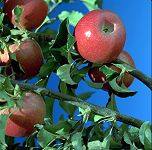


|
HOME EARLY SUMMER · Apples · Apricots · Apriums · Artichokes · Cherries · Figs · Grapes · Nectarines · Peaches · Plums · Pluots MID SUMMER · Apples · Artichokes · Asian Pears · European Prune-plums · Figs · Grapes · Mangos · Nectarines · Peaches · Pears · Plums FALL · Apples · Asian Pears · Grapes · Kiwi Fruit · Oranges · Pears · Persimmons · Pineapple · Plums · Pomegranates WINTER · Apples · Asian Pears · Avocados · Grapes · Grapefruit · Kiwi · Kumquats · Oranges · Pears · Strawberries · Tangerines COMPANY CONTACTS |
Apple Fruit Facts and Information | |
|
Locate a Gift Catalog with Apple Availability by Variety Recipe Search & More Information | |
 APPLES - The native home of the apple is not definitely known, but the tree originated probably in the area between the Caspian and the Black seas. Charred remains of apples have been found in the prehistoric lake dwellings of Switzerland. Evidence shows that man has been enjoying apples for at least
750,000 years!
Apples were a favorite fruit of the ancient Greeks and Romans.
APPLES - The native home of the apple is not definitely known, but the tree originated probably in the area between the Caspian and the Black seas. Charred remains of apples have been found in the prehistoric lake dwellings of Switzerland. Evidence shows that man has been enjoying apples for at least
750,000 years!
Apples were a favorite fruit of the ancient Greeks and Romans.The apple was introduced to America by early settlers, who brought apple seeds with them. Records of the Massachusetts Bay Company indicate that apples were grown in New England as early as 1630. Seeds were carried westward by missionaries, traders, and Native Americans. One man alone, John Chapman (Johnny Appleseed), was responsible for extensive plantings of apple trees in the midwestern United States. Consumption: Apples, as eaten in the fresh state, are a healthy refreshing, crunchy snack. They quench your thirst and their acid content makes them a natural mouth freshener. To bite into a fresh picked apple is a memorable experience. The juice is honey sweet and spicy tart at the same time and the flesh is fragrant and crisp. Nutritional Facts: • High in fiber • High in vitimen C and potassium • Low in Sodium • Almost fat-free How to Store: The best place to store apples is in the refrigerator! Sliced or cut apples stay white longer if dropped in a bowl of water containing 2 tablespoons of lemon juice. Detailed nutritional informatin can be found by searching the USDA Nutritional Database. Enter "Apple" (no quotes) as the keyword and select the link and report of interest. Scientific classification: Apple trees belong to the family Rosaceae. They constitute the genus Malus. |